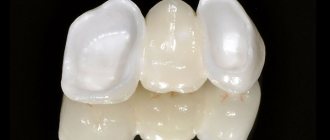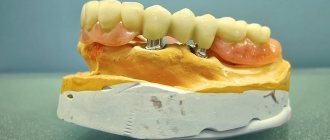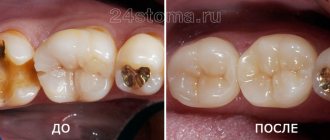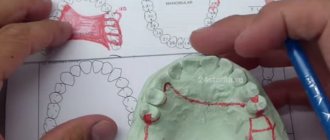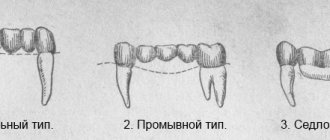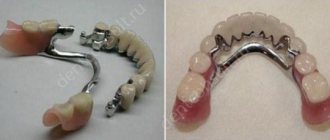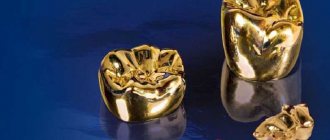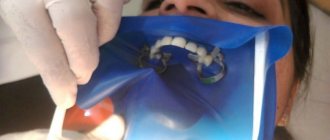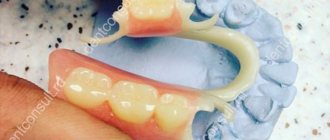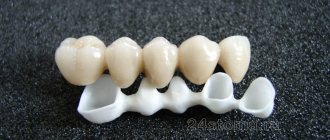Clasp prosthesis with attachments is the most aesthetic option for removable prosthetics.
Its design is based on an arched frame or clasp made of durable metal. A polymer base with artificial teeth made of ceramics or other materials is attached to it.
The prosthesis is fixed on the supporting teeth, covered with a metal-ceramic crown. On the inside of the crown there is a miniature lock-attachment that securely fastens the prosthesis to itself.
You can install a fixing mechanism not only in the crown of the tooth, but also in a healthy root.
Clasp dentures, what are they?
Clasp dentures are removable or partially removable supporting structures designed to replace missing teeth. One of the main elements of clasp devices is the arch, which, together with the holding elements and bases, performs the function of a frame. The name of the device comes from the German Bugel - arc. Therefore, clasp instructions are sometimes called “arc” instructions.
The chewing load in clasp appliances is distributed to the periodontium of the supporting teeth and the mucous membrane of the gums in the place of missing units.
The device consists of:
- clasp (arch);
- bases with artificial teeth, sometimes called “saddles” because of their shape;
- support-retaining devices.
The clasp, which is an arc in shape, is made of chromium-cobalt, chromium-nickel or gold alloys in the form of solid cast or bent and soldered structures. The main requirements for the clasp are to ensure high structural rigidity with a small cross-sectional area.
Bases are saddle-shaped elements that cover toothless areas of the gums and carry artificial teeth. The functions of the base include holding artificial teeth, transferring the chewing load to the alveolar process, and counteracting displacement forces.
Support-retaining elements in the form of clasps, various locking devices (attachments), telescopic, beam and magnetic structures are designed to fix the prosthesis and transfer part of the chewing forces to the supporting teeth.
Bottom line
Strong fixation, ease of use, ease of cleaning and lack of discomfort during communication - all types of attachments have been highly appreciated by patients in dental clinics. Despite the high price, the attachment system pays for itself due to its long service life and inexpensive maintenance.
Hook-mounted dentures are becoming a thing of the past. The attachment system is more advanced and convenient. The range of lock fastenings includes more than one hundred items. Each type differs from the other in a special way of fastening, size and functionality. The price range for a prosthesis with an integrated attachment system ranges from 100 to 1200 conventional units. The price includes the price for diagnosis, installation, the orthodontic product itself and the lock for it.
Sources used:
- “Removable dentures: a textbook” (Mironova M.L.)
- Murray JJ (Nov 2011). “Adult dental health surveys: 40 years on.”
- Artun J, Smale I, Behbehani F, Doppel D, Van't Hof M, Kuijpers-Jagtman AM (2005).
Indications for the use of clasp structures
- 2-sided end defects (there are no distally located teeth that can be used as supporting ones).
- Unilateral end defects.
- Absence of more than 3 lateral teeth in a row (a permanent bridge cannot be used).
- Absence of more than 4 frontal teeth in a row (for the same reason as stated above).
- Multiple missing teeth.
- Adentia in combination with periodontitis.
Contraindications
The installation of structures is contraindicated in the following cases:
- The presence of less than 4 healthy teeth in the jaw;
- Complete edentia;
- Low level of hygienic care;
- Allergic reaction to the materials used;
- Periodontal disease in stage 3;
- Severe bone atrophy;
- Pregnancy and lactation period;
- Acute viral, bacterial diseases;
- Exacerbation of chronic pathologies of the body;
- Mental disorders;
- Serious diseases that cast doubt on the success of treatment (oncology, tuberculosis, diabetes, AIDS, etc.)
What is an attachment, clasp dentures on attachments?
An attachment or attachment is a mechanism designed to fix dentures. Consists of two elements:
- patrix - the internal part of the mechanism in the form of a cylindrical, spherical or other oval-shaped body;
- matrix - the outer part of the mechanism, covering the patrix.
One part of the attachment is attached to the prosthesis, the other to the crown or root of the tooth. Can be attached to an implant. When fixing the device, the patrix enters the matrix, providing a reliable connection between the clasp product and the supporting teeth.
To date, more than 100 types of attachments have been developed and used. Their classification is very extensive. The devices are divided into:
- According to the material. Precision metal alloys and plastics are used. Standard factory products are usually made from metal, and individual designs in laboratory conditions are made from polymer.
- By design. Rail, beam, spherical, joint, crossbar, rod.
- According to the functions performed. Supporting, holding, guiding, anti-tipping, load distributing.
- By location. Intercoronal, extracoronal, intracoronal.
- According to the degree of mobility between the patrix and the matrix. Hard, semi-labile, labile.
- According to the method of fixation. They can hold the prosthesis due to friction, magnets, screws, and mechanical retention.
- According to the manufacturing method. Accurate (precision) semi-precision or laboratory. Devices of the first type are manufactured by factory precision casting (with no shrinkage) from cobalt-chromium, titanium or gold-platinum alloys. Semi-precision products are also manufactured in a factory way, but from ashless thermoplastic or wax. When making clasp devices, they are attached to the wax elements of the frame and cast together with the entire structure. Due to their low cost and the ability to manufacture them in a laboratory, clasp dentures with plastic attachments are widely used. Lock matrices are made of nylon, Teflon, lavsan and other polymers.
The simplest rod attachments in design are a male rod in the form of a rod and a cylindrical matrix into which the male rod enters.
The spherical structures are made in the form of a “push button”. The split matrix with a spherical cavity includes a patrix having a head in the form of a sphere.
Standard metal attachments are produced by many international companies (Italy), ZL, Servo-Dental and Bredent (Germany), SEKA (Belgium), Elephant (Holland). Some manufacturers color-code their products to indicate the material from which they are made; yellow – noble metals, blue – base alloys.
In case of loss of retention as a result of operation or, conversely, excessive retention, the matrices can be replaced with new ones that provide strengthening or weakening of retention. Only one type of attachment is used for one prosthesis. Mixing different types of locks leads to deformation and reduced service life of the product.
What types of attachments are there?
Today there are dozens of varieties of dental attachments, but the main ones include the following:
- Intracoronal - hidden inside the abutment tooth or crown, therefore not visible from the outside.
- Extracoronal – attached externally, which provides the necessary mobility.
- Root pins – are installed directly on the root of the tooth.
- Crossbars - use a kind of small valve.
- Anchor (spherical) - the male is made in the shape of a ball.
- Rail - the patrix has a T-shape, which increases the friction force.
- Rod (beam) implants are connected to each other by a transverse beam, for which a groove is provided in the prosthesis.
Interesting fact!
Ball-shaped fixation on attachments is the most common type of locking fastening.
Attachments for teeth in different situations must transfer the load differently; accordingly, they can be hard, medium-hard or soft. For the convenience of doctors, locks are marked in different colors: for example, the German Bredent attachments use red to indicate a rigid attachment that loads only the supporting tooth. Green indicates lability, which is necessary to distribute chewing pressure more evenly.
To make locks, metal and plastic or combinations thereof are used.
Advantages of attachments over clasps
Clasps are the simplest supporting and holding structures. In its simplest form, it is a bracket that covers the abutment tooth. The advantages of clasps include simplicity of design and low cost. However, functionally they are inferior to attachments, which have the following advantages in comparison with them.
- Reliable fixation.
- More apical application of force.
- Standardization of parts (allows you to quickly replace a failed element).
- Possibility of repair, activation and wear monitoring.
Bredent attachment design
The German company Bredent is a manufacturer of a wide variety of types of attachments. However, it is often associated only with a spherical type of fastening.
The Bredent attachment consists of the following parts:
- Patrix - a metal ball that is located on the crown of an abutment tooth, an implant, or directly at the root;
- Matrix – a plastic part with a recess the size of the matrix.
The attachment can be latched mechanically, screw or magnetically. Ball mounts have become popular due to their versatility and reliability, but they are not always the only correct solution.
Disadvantages of locking devices
- The need to cover the tooth with a crown (not required in all cases, but in most cases).
- in case of terminal defects, at least 2 teeth should be used for support.
- The height of the clinical crown, as well as the distance between the alveolar process and the antagonist teeth, must correspond to the norm (not be too small).
- Some structures undergo rapid wear, resulting in loss of retention.
- There is a “cantilever effect” with extended end defects (too much impact on the supporting teeth).
- The laboratory must be equipped with high-tech equipment.
- Relatively high cost.
Pros and cons of clasp dentures
By changing the shape of the arch if necessary, almost any defect can be replaced with clasp devices. In addition, clasp structures are distinguished by:
- high functionality and aesthetics;
- distribution of the load between the mucous membrane of the gums and the supporting teeth (this allows to reduce the load on the periodontium of the supporting teeth);
- the presence of a splinting effect, which increases the stability of the teeth and eliminates their overload;
- elimination of horizontal load on the alveolar processes and supporting teeth;
- the possibility in some cases to refuse tooth preparation;
- minimal disturbances in tactile, taste and temperature sensitivity of the oral cavity;
- fairly good functionality even with a high degree of edentia (with only a few teeth);
- quick addiction;
- long service life.
Manufacturing stages
Prosthetics consists of the following stages:
- Examination and examination of the patient;
- Making a diagnosis, selecting an orthopedic design;
- Preparation of the oral cavity – professional cleaning, sanitation;
- Taking dental impressions;
- Manufacturing of structures in a dental laboratory;
- Trying on a clasp, choosing a fixation method, teeth color;
- Fixation of the finished product;
- Advice and recommendations for the patient.
Advantages of clasp dentures compared to plate ones
- The small volume of the base part, which increases the comfort of using the prosthesis, eliminates pronunciation problems and nausea that some patients experience with plate structures on the upper jaw.
- The presence of an arch allows you to evenly distribute the chewing load between different sides of the prosthesis.
- Support clasps and attachments partially transfer the load through the supporting teeth, thereby reducing the pressure on the mucous membrane of the prosthetic bed.
- The gingival papillae and a significant part of the mucous membrane are freed from coverage by the base plate.
- Possibility of device correction.
Alternative prosthetic options
In general, devices with attachments are a kind of “golden mean” among removable ones. Because they look aesthetically pleasing enough that from the outside it seems like they are your own teeth. Their cost is lower than, for example, structures with telescopic crowns and conditionally removable ones with implants. By the way, the listed options may well become the best alternative to attachments.
As an alternative, in case of complete or almost complete edentia, you can pay attention to removable ones with clasps or with fixation on the gums. These are plate or covering prosthetic devices, nylon, Acry-free (“Acry-Free”), Quattro Ti (“Quadrotti”). However, the best option is permanent prosthetics on implants. Patients note that this is the most comfortable and durable method of restoration. Since there is no risk of the prosthesis moving or falling out of the mouth, and the atrophy of the alveolar ridge also stops.
PROSTHETICS WITH 6 OSSTEM IMPLANTS FROM RUB 200,000.
Complex implantation Osstem (South Korea) with delayed loading after 4-6 months.
Call now or request a call
Manufacturing and installation features
Clasp dentures are manufactured in a clinic and laboratory according to a standard procedure. First, a diagnosis is made, on the basis of which a treatment plan is drawn up.
During examination, it is important to determine the boundaries of the clasp prosthesis. Therefore, special attention is paid to palpation of the alveolar process. In general, the order of work before casting the apparatus is as follows:
- patient interview;
- study of anamnesis;
- radiography (orthopantomography, telefluoroscopy, targeted intraoral images).
- establishing diagnosis;
- drawing up a treatment plan;
- taking an impression (alginate or two-component silicone compounds are used);
- production of a diagnostic model;
- establishment of bite;
- measurements and model study;
- planning a clasp prosthesis;
- modeling of abutment teeth;
- taking a working impression;
- molding a master model;
- main laboratory stage (casting).
When manufacturing and installing a prosthesis, pay attention to the distance between the arch and the oral mucosa. It should be no less than the value of the tissue compliance of the prosthetic bed (0.3-1 mm depending on the location). This is necessary so that the arc does not injure the soft tissues of the oral cavity, including the frenulum, when chewing.
There is no agreement among experts about what parameters of the arc section are optimal. In general, the arch for the upper jaw should have a thickness of 0.6-0.8 mm and a width of 5-10 mm. The clasp for the lower jaw should be about 1.5 mm thick and at least 3 mm wide. However, depending on the clinical situation, arches of other sizes can be used. In general, the smaller the cross-section of the arch, the more favorable conditions are created for pronunciation and swallowing. However, the limiting factor for downsizing is the need to ensure arch rigidity.
What are the advantages of our clinic in Moscow?
- Experience. We have been installing clasp dentures on attachments for 10 years and know how to maximize their service life, impeccable aesthetics, and complete functionality.
- Technologies. We have at our disposal advanced equipment and certified safe materials, which helps to achieve the goal of replenishing the loss.
- Quality. When it comes to the final result, we do not compromise. Each one is strictly monitored for predictable and reliable results.
- Guarantees. We are confident in our work, so we provide a 5-year guarantee on all types of work. If anything breaks down during this time, we will repair it free of charge.
- Prices. We are trying to make prosthetics more accessible by offering payment in installments, on credit, and providing tax deductions. In addition, we regularly hold promotions.
Prosthetics is our main activity, we know how and we can do it. And the thousands of attachment-based prostheses we have installed and many others are already performing their function right now.
Structure care
Caring for clasp devices consists mainly of keeping them in perfectly clean condition. For this:
- After each meal, rinse the mouth with boiled water.
- Once a day, the prosthesis is treated by lowering it for 5-10 minutes in a solution prepared from special disinfectant tablets.
- Once a week, the device should be treated with a special solution that removes stubborn stains and food residues. After treatment, the structure is washed with clean water.
- Once every six months, it is recommended to have the device professionally cleaned in a dental clinic to remove solid deposits. After cleaning, the specialist will assess the condition of the prosthesis, eliminate any cracks found, and, if necessary, adjust (calibrate) the device to the patient’s jaw.
You need to brush your teeth at least 2 times a day - in the morning and before bed. Cleaning the clasp device is done with the same movements as natural teeth. When caring for the oral cavity, in addition to a regular toothbrush, it is necessary to use additional cleaning products.
- Special brushes.
- Mono-beam brushes.
- Dental floss (floss).
Cannot be used for cleaning:
- abrasive materials;
- toothpaste with whitening effect.
It is not recommended to: smoke - to avoid yellowing of the teeth and the appearance of plaque on the teeth, which is favorable for the development of bacteria, and drink strong tea, coffee, and consume other products with a strong coloring effect.
Negative factors influencing accelerated wear of the prosthesis.
- High temperature, chemical and mechanical effects.
- Using a damaged device. In addition to the fact that the operation of a damaged device can lead to its irreparable breakdown, pathogenic bacteria that infect the oral cavity accumulate in the cracks. Therefore, if there are any malfunctions, it is necessary to take the product for repair.
Adjustment and storage
Every six months, the clasp apparatus must be examined by a specialist to check its condition. If necessary, relocation is carried out. The need for it is determined by the natural change in the shape of the alveolar process. In the absence of teeth and normal physiological load, the bone tissue of the alveolar process atrophies, which leads to a change in its shape.
You should not attempt to repair the denture yourself. This can lead to the opposite effect - the appearance of irreparable defects.
Proper storage of the clasp prosthesis is carried out as follows. The structure is thoroughly washed, dried and placed in a special case. In this state it can be stored for a month. Long-term non-use of the device is not recommended, especially if it is also used for splinting.
